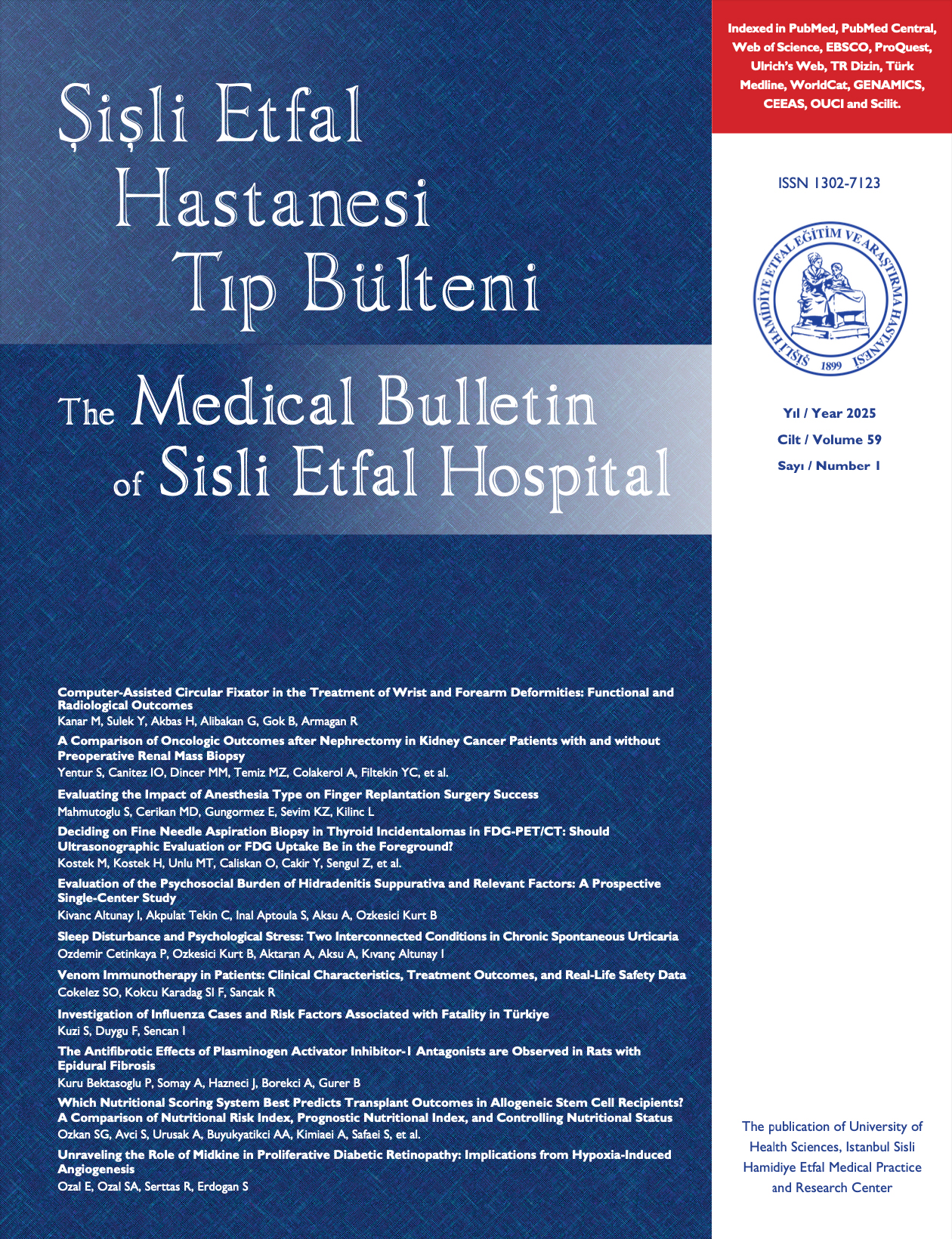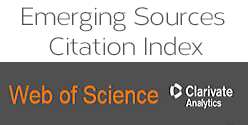
Volume: 44 Issue: 3 - 2010
| ORIGINAL RESEARCH | |
| 1. | The effects of working in intensive care unit for the assistant doctors of the department of anesthesiology and reanimation, for the burnout, work-related stress, work satisfaction and state-trait anxiety levels Deniz Erdem, Harun Atçı, Belgin Akan, Demet Albayrak, Derya Gökçınar, Nermin Göğüş Pages 93 - 99 Work stress can be defined as the situation that makes person stressful which occur from physical and emotional responses and capability of workers. The end point of this process can set as Burnout syndrome if the methods to cut down the stress were insufficient. The aim of this study was to determine the burnout, work-related stress, work satisfaction and state-trait anxiety levels at the beginning and at the end of the period in assistant doctors who work in Intensive Care Unit (ICU) of the department of anesthesiology and reanimation in the Numune training and research hospital. Maslach Burnout Inventory (MBI), Minnesota Satisfaction Inventory (MSI), Work-Related Strain Inventory (WRSI) and State-Trait Anxiety Inventory (STAI) scales were used in the evaluation. These tests were done at the first day, in the middle and at the end of their work period of the assistants in the ICU. At the end of the study the mean level of end-time WRSI was higher than at the beginning time and the mean level of end-time MSI was lower than at the beginning time. These differences were clear but not statistically significant. The personal accomplishment scores of MBI at women were higher than men and same scores of the assistants whose experiences in ICU were more than 5 months was higher than the others and these differences were statistically significant. In conclusion it can be said that the way of getting more productivity from health personal is to lack of workrelated stress. |
| 2. | Common skin findings in children with acute leukemia Eylem Ceren, Gonca Gökdemir, Zeynep Yıldız Yıldırmak, Adem Köşlü Pages 100 - 105 Aim: Leukemias are the most common malignancies in childhood with a proportion of %25-40. Manifestations of the skin findings can be a router. There are only a few researches in the literature about this subject. Our aim was to determine the skin findings in children with acute leukemia. Materials and Methods: The cases who were treated and followed up in Pediatric Hematology and Oncology Clinics were included in the study. The diagnose and duration of the disease, whether in remission or not and patients treatment were noted. Dermatologic examination was recorded as a standard form. Results: 59 acute leukemia patients (32 boys, 27 girls; aged 18 months to 17 years - mean: 8.69 years) were included in the study. 6 of the patients were acute myeloblastic leukemia and 53 of them were acute lymphoblastic leukemia. Patients were seen 1-6 times (mean: 2.30) and disease periods were 1 month to 8 years (mean: 2.31 years). 89.8% of the patients were in remission (53/59: 31 boys, 22 girls). In the cases of 93.2%, skin lesions were observed at least one examination (except 1 acute myeloblastic leukemia and 3 acute lymphoblastic leukemia patients). Skin infiltration of acute leukemia was not found. Kserosis, diffuse alopecia, miliaria, purpura and pitriasis simplex were the most frequent dermatoses. Conclusions: 93.2% of the patients were observed to have skin lesions. Nonspesific skin lesions were detected in the foreground. Although these results are compatible |
| 3. | The role of orthopedics in multidisciplinary approach to diabetic foot wounds Yavuz Arıkan, Ünal Kuzgun, Cem Sever, Rafi Armağan Pages 106 - 112 Objective: Owing to management of diabetic foot wounds (DFW) need severe and long-term treatment protocol that concerns many departments; diabetic foot ulcers necessitate multidisciplinary approach. Therefore a council was constituted that called Wound Council, included five deparments (endocrinology, infectious diseases, dermatology, orthopedics and plastic surgery) in Sisli Etfal Research an Training Hospital. The purpose of this study was to inform about the wound council and to emphasise the role of orthopedic approach to DFW. Methods: A total of 42/154 patients (29 male and 13 female; mean age: 66) who had DFW, were evaluated on Sisli Etfal Research and Training Hospital - Wound Council and were decided to be treated by 1. Orthopaedics and Traumatology Clinic were included in this study. Patients demographic findings such as gender, age, location and duration of wound, wound culture, results of angiography, presence of vascular pathology, blood sugar levels, wound stages according to Wagner classificaion, surgical prosedures, complications and period of hospitalization were noted. Results: Fifty one meeting were done in Sisli Etfal Research and Training Hospital - Wound Council between 2007-2009 and 154 patients were assessed. 120 of patients (76 male, 44 female and mean age: 58.6) had diabetes (type 1/2=3/117). Wound durations were changing between 2 weeks and 18 years. 42 of these patients who were hospitalized to 1. Orthopedics and Traumatology Clinic had tipe 2 diabetes mellitus (DM) and their mean wound durations were 3.4 month. Staphylococcus aerius were the more spawning microorganism. According to Wagner classification; more half of patients were stage 4 and 5 (55.7%). 59.5% of patients had lower knee and 23.8% of patients had upper knee amputations. In addition debridement and drainage were applied to five of them, hyperbaric oxygen therapy (HBO) were added 3 of them and vacumm assisted closure (VAC) were added in 3 of them each. Reamputation precedure were applied to 9 of patients who had infection on postoperative follow-up period. Period of hospitalization period were 4-22 days (mean: 13.2). Conclusion: Consultation traffic of necessary departments for the patients who have DFW decreases with mutidisciplinary approach. Weve understant that orthopedic practice has an important place in this team. According to our study; for effective treatment of this DFW patients, multi clinical assessement can increase the success instead of single approach. |
| CASE REPORT | |
| 4. | Multiple basal cell carcinoma lokalized on neck and scalp Ali Okan Gürsel, Cüneyt Kucur, Ahmet Karavuş Pages 113 - 115 The most important etiologic factor of basal cell carcinoma, which is the most frequent primer skin cancer, is ultraviolet light exposure. Typically it occurs in areas of chronic sun exposure. Synchronous multiple tumors are exceptional and if present, they are commonly associated with a syndrome. In a 58 years-old woman, ulcerated and crusted, macular and nodular lesions on neck and scalp were excised and pathologic examination of all lesions revealed as basal cell carcinoma. No accompanying syndromic finding was found. Non-syndromic multiple basal cell carcinomas are rare in the literature. Since increasing effect of ultraviolet light with aging may cause multiple tumors, the follow up of these patients are significant. |
| 5. | Lipomatous hemangiopericytoma (Fat- containing variant of solitary fibrous tumor) Fevziye Kabukçuoğlu, Ayşim Özağarı, Yavuz Kabukçuoğlu, Gürkan Yetkin Pages 116 - 119 Lipomatous hemangiopericytoma is an uncommon, slow-growing benign mesenchymal neoplasm, composed of mature adipocytes and hemangiopericytoma-like areas. The deep soft tissues of the lower extremity and the retroperitoneum are mostly affected. This unique variant of hemangiopericytoma was described by Nielsen in 1995. A 36 year old male presented with a 12 year history of a slowly enlarging mass in the right inguinal region. 14 cm, mobile, painless mass within deep soft tissues was detected. Biopsy findings were consistent with hemangiopericytoma. The mass was totally excised. On gross examination the tumor was a 14x10x7 cm, well-circumscribed, firm, solid mass. It was yellowish tan on cross section. Microscopically it was composed of cellular areas admixed with single cells, clusters or lobules of mature adipocytes. The histopathological findings were interpreted as lipomatous hemangiopericytoma. Five year follow up of the patient showed no recurrence. Histopathological and clinical features of this distinctive tumor is presented with a brief discussion of its origin. |
| 6. | Trans arterial microcatheter embolization treatment for bleeding bronchial artery branch Kosti Can Çalışkan, Sıtkı Mert Ulusay, Ender Uysal, Şebnem Türk, Zeki Karpat Pages 120 - 123 In the case which is followed in intensive care unit because of multitrauma, reiterative hemoptysis issue due to hemorrhage arising from right bronchial artery was treated with the operation of endovascular embaluzation of bronchial arter. Hemoptysis was not detected after the operation. In the course of patients long duration in intensive care unit, developing pneumonia in lower lobe of right lung and trauma which happenned in lung parenchyma because of intubation cannula during the process of intubation pave the way for hemoptysis, in the case, which was thought that the patient cannot tolerate surgical treatment, endovascular treatment was got off the ground by using embolizan material coil combination. |
| 7. | Neonatal abstinence syndrome Emrah Can, Ali Bülbül, Sinan Uslu, Ömer Güran, Asiye Nuhoğlu Pages 124 - 127 Neonatal abstinence syndrome is characterized by a clinical situation with withdrawal symptoms and physical dependence in the uterus exposed to addictive substances in infants. The well-known method in diagnosis of neonatal abstinence syndrome is to identify addictive substances in the first meconium. The prevalence of neonatal abstinence syndrome is between 16-90% in infants of mothers who used heroin. Clinical findings often occur within the first 48-72 hours. Most obvious symptoms are tremor and hiperirritability. Neonatal central nervous system is most common affected. Gastrointestinal system creates a second often affected. Mortality associated with premature birth problems, infections and perinatal asphyxia. This syndrome should be treated when it were convulsions, diarrhea, sleep and diet in the presence of the distorting extreme deprivation syndrome. Treatment of the syndrome were important by opium, benzodiazepines, phenobarbital with calm and quiet environment and to minimize the stimulus into newborn. In this article presented with neonatal abstinence syndrome detected by a dependent mothers baby heroin use during pregnancy period. |
| 8. | Atelectasis in a case with larynx tumour after urgent intubation Müge Coşkun Çelik, Ayşe Hancı, Şebnem Türk, Melehat Erol, Birsen Ekşioğlu Pages 128 - 130 The imminent airway obstruction caused by a tumor of the larynx must be control quickly. However, this kind of intubations with unexpected tumors may be traumatic. In this case report; a case with laryngeal tumor admitted to emergency department due to progressive breathing diffuculty and later was intubated because of downing consciousness level and severe respiratuar acidosis, was illustrated. During intubation the tumor was seen and he was taken to operation for tracheostomy. In postoperative period, after oscultation of thorax at left lung field breath sounds couldnt taken and atelectasis was seen in thorax graphy. A computed tomography scan of the thorax, rigid bronchoscopy performed and fiberoptic bronchoscopy was planned.The patient, spontaneously removed the fragment after tracheal aspiration. The pathology result of the fragment reported as larynx squamöz cell CA. In this case report we want to emphasize when confronted with unexpected tumors of larynx in course of laryngoscopy, the travmatization of the fragment must be considered. The oscultation of lung and controlling with thorax graphy is so important. |
| 9. | Fetal intracranial hemorrhage associated with alloimmune thrombocytopenia Emrah Can, Muhittin Çelik, Ali Bülbül, Sinan Uslu, Selda Arslan Pages 131 - 133 Cerebral hemorrhage during fetal period may be related to various etiologies. The frequency of intraventricular hemorrhage in neonates is reported to be 25-45%. Neonatal alloimmune thrombocytopenia (NAIT) develops when fetal thrombocytes lack an antigen which is derived either from mother or the father. Typically affected newborns are healthy after birth and during early postnatal period, they may show moderate or severe symptoms including fetal intracranial hemorrhage related to the degree of thrombocytopenia. A newborn with an antenatal diagnosis of fetal intracranial hemorrhage who postnatally was found to have NAIT was presented in this case report. |
| 10. | Congenital cytomegalovirus Infection: a case report Emrah Can, Selda Arslan, Serdar Çömert, Ali Bülbül, Sinan Uslu Pages 134 - 136 Gancyclovir and valgancyclovir treatment in congenital CMV infection with central nervous system involvement is controversial. A term neonate delivered via vaginal route was found to have dysmorphic facies and a palpable liver extending 3 cm below intercostal margin. The detection of enlargement of subarachnoid space, ventricular dilatation and periventricular calcification in cranial computerized tomography suggested congenital CMV infection. Serologic tests of the patient revealed that CMV IgM was positive. The mothers serology was found to be CMV IgG(+) and CMV IgM(-). Chorioretinitis was not found in ophtalmological examination. Brain stem evoked potentials and audiometric evaluation were found to be normal. After detection of CMV DNA positivity in PCR, gancyclovir treatment was continued for 6 weeks. Multisystemic involvement in congenital CMV infection should be suspected and in case of central nervous system involvement, medical treatment should be initiated. |
| REVIEW ARTICLE | |
| 11. | Use of nonpharmacologic relaxation and tactile stimulation methods in labor pain Rojjin Mamuk, Naile Inci Davas Pages 137 - 144 Nonpharmacologic pain control methods emerging from different cultures via trial and error method are highly economical, comfortable, reliable and easy to use applications. These methods, whose analgesic effects are explained with door control theory and endorphin theory, decrease anxiety and fear, increase pain control and support comfort at birth. In the literature, nonpharmacologic pain control methods are analyzed under four groups; namely, relaxation, tactile stimulation, psychic stimulation and respiratory techniques. This collection will handle how to use nonpharmacologic relaxation and tactile stimulation methods in birth, which are used for pain control and for providing relaxation. |



















